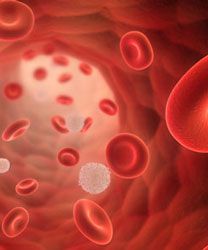Ixazomib Receives NICE Recommendation for Multiple Myeloma Through CDF
The proteasome inhibitor ixazomib has received a recommendation from the United Kingdom's National Institute for Health and Care Excellence for patients with relapsed/refractory multiple myeloma.
blood cells

Ixazomib (Ninlaro) has received a recommendation from the United Kingdom's National Institute for Health and Care Excellence (NICE) for patients with relapsed/refractory multiple myeloma.1
The proteasome inhibitor, developed by Takeda, is indicated for use in combination with lenalidomide (Revlimid) and dexamethasone for patients who have already undergone 2 or 3 prior lines of therapy. The drug would be made available through the Cancer Drugs Fund (CDF), which is designed to provide patients with faster access to the most promising new cancer treatments, improve cost effectiveness, and offers pharmaceutical companies a fast-track route to funding from the National Health Service (NHS).
Ixazomib is already approved for patients who have had at least one 1 prior treatment. In its final appraisal, NICE recommended ixazomib for the CDF because the drug requires more data demonstrating its value.
“Ixazomib has the potential to be cost effective for people who have had 2 or 3 lines of therapy, at the price agreed in a commercial access agreement as part of the managed access agreement,” the appraisal said. “But more evidence is needed to address the clinical uncertainties. It can therefore be recommended for use within the Cancer Drugs Fund while further data are collected from the clinical trial, and through the Systemic Anti-Cancer Therapy dataset.”
NHS England and Takeda have a commercial access agreement that makes ixazomib, with lenalidomide and dexamethasone, available to the NHS at a reduced cost. The financial terms of the agreement have not been released.
NICE estimates that the incremental cost-effectiveness ratios (ICER) for ixazomib will be £31,691 ($42,408) per quality-adjusted life-year (QALY) gained compared with lenalidomide plus dexamethasone. A slight improvement in the hazard ratio for overall survival (OS) could bring the ICER to less than £30,000 ($40,145) per QALY gained.
NICE rejected ixazomib in this population in September 2017, citing questions over the drug’s ability to improve OS. OS data from the pivotal phase III TOURMALINE-MM1 study, which was used to support approvals in the European Union and United States for patients who had undergone 1 prior treatment, is still maturing, but the OS with standard lenalidomide and dexamethasone treatment is 3.9 years, greater than the 24 months required by the end-of-life criteria.2
NICE estimated that adding ixazomib would extend survival by roughly 18 months, which is not considered an “exceptional proportional gain.”
“The committee agreed that further data collection would reduce the uncertainty about the survival benefit of ixazomib, but did not see any plausible potential for ixazomib to satisfy the end-of-life criteria based on the current estimates of life expectancy and proportional survival gain with ixazomib,” the final appraisal said.
In TOURMALINE-MM1, the median progression-free survival with the ixazomib triplet was 20.6 months compared with 14.7 months with lenalidomide and dexamethasone alone (HR, 0.74; 95% CI, 0.59-0.94;P= .01), according to findings published in theNew England Journal of Medicine. A very good partial response or better was achieved by 48% of those treated with ixazomib versus 39% in the control arm (P= .01).
Investigators randomly assigned patients receive lenalidomide and dexamethasone with placebo (n = 362) or ixazomib (n = 360). Ixazomib was given orally at 4 mg on days 1, 8, and 15 of a 28-day cycle. Patients received oral lenalidomide at 25 mg on days 1 to 21 and dexamethasone was administered orally at 40 mg on days 1, 8, 15, and 22.
The median age of patients was 66 years, and 12% had ISS stage III disease at baseline. The ECOG performance score was primarily 1 or 2 (94%). The median creatinine clearance was 78.4 ml/min (range, 20-233) and 19% of patients had high-risk cytogenetics, including 10% with 17p deletion.
Most patients had received 1 prior therapy (61%), with 10% having received 3. Overall, 57% of patients had received prior stem cell transplantation, 77% had relapsed multiple myeloma, and 12% were both relapsed and refractory. Prior therapies included bortezomib (Velcade; 69%), thalidomide (Thalomid; 45%), and lenalidomide (12%). Twenty-three percent of patients had disease that was refractory to prior immunomodulatory agents.
The overall response rate (ORR) was 78.3% with the ixazomib triplet versus 71.5% in the control arm (P= .04). The complete response rate with the proteasome inhibitor was 12% versus 7% with placebo (P= .02). The median duration of response was 20.5 months with ixazomib versus 15.0 months in the control arm.
References:
- NICE.org/uk. Final appraisal determination: Ixazomib with lenalidomide and dexamethasone for treating relapsed or refractory multiple myeloma. https://www.nice.org.uk/guidance/gid-ta10043/documents/html-content-3. Updated December 19, 2017. Accessed December 19, 2017.
- Moreau P, Masszi T, Grzasko N, et al. Oral ixazomib, lenalidomide, and dexamethasone for multiple myeloma.N Engl J Med. 2016;374:1621-1634.